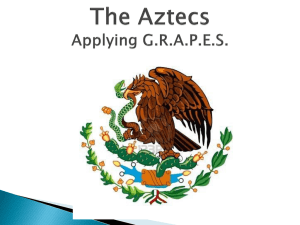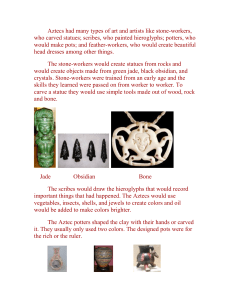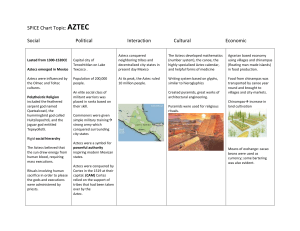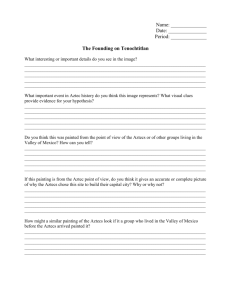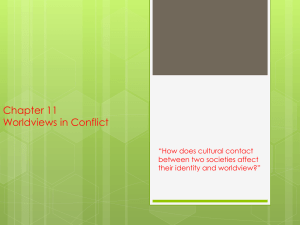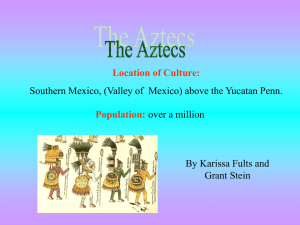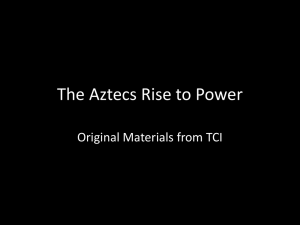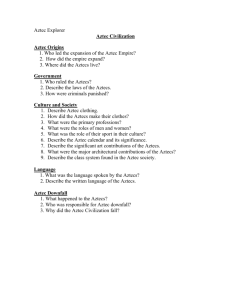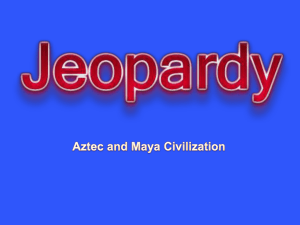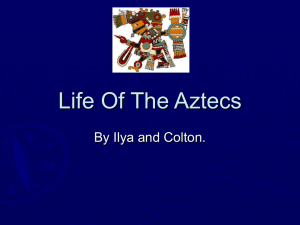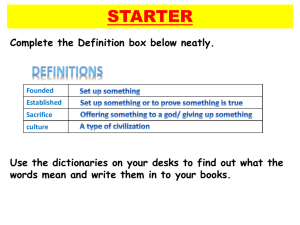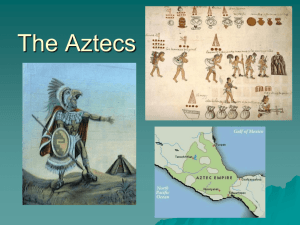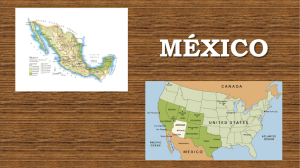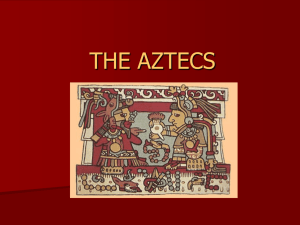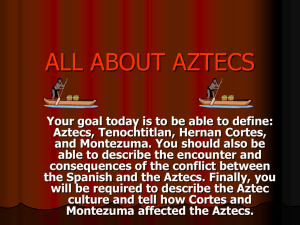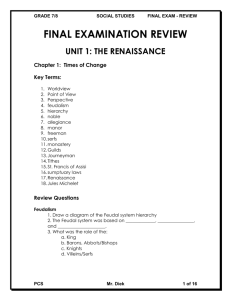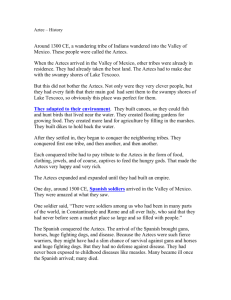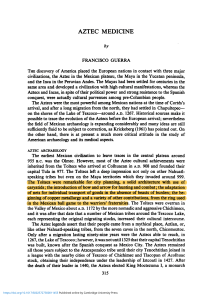Get to Know the Aztecs
advertisement
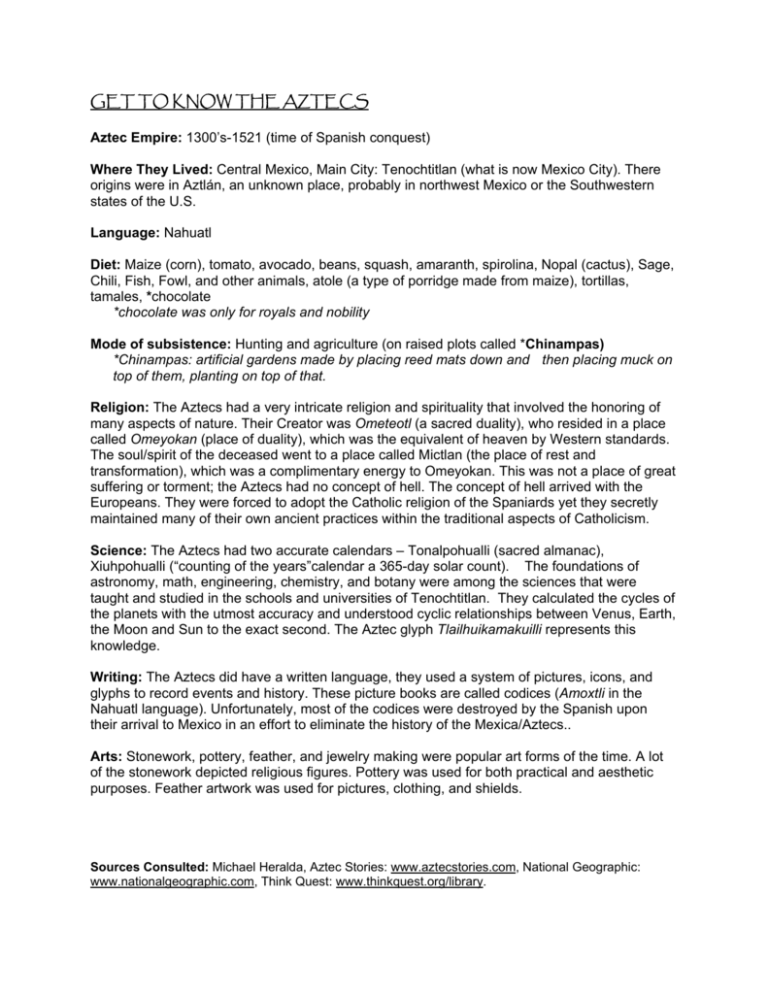
GET TO KNOW THE AZTECS Aztec Empire: 1300’s-1521 (time of Spanish conquest) Where They Lived: Central Mexico, Main City: Tenochtitlan (what is now Mexico City). There origins were in Aztlán, an unknown place, probably in northwest Mexico or the Southwestern states of the U.S. Language: Nahuatl Diet: Maize (corn), tomato, avocado, beans, squash, amaranth, spirolina, Nopal (cactus), Sage, Chili, Fish, Fowl, and other animals, atole (a type of porridge made from maize), tortillas, tamales, *chocolate *chocolate was only for royals and nobility Mode of subsistence: Hunting and agriculture (on raised plots called *Chinampas) *Chinampas: artificial gardens made by placing reed mats down and then placing muck on top of them, planting on top of that. Religion: The Aztecs had a very intricate religion and spirituality that involved the honoring of many aspects of nature. Their Creator was Ometeotl (a sacred duality), who resided in a place called Omeyokan (place of duality), which was the equivalent of heaven by Western standards. The soul/spirit of the deceased went to a place called Mictlan (the place of rest and transformation), which was a complimentary energy to Omeyokan. This was not a place of great suffering or torment; the Aztecs had no concept of hell. The concept of hell arrived with the Europeans. They were forced to adopt the Catholic religion of the Spaniards yet they secretly maintained many of their own ancient practices within the traditional aspects of Catholicism. Science: The Aztecs had two accurate calendars – Tonalpohualli (sacred almanac), Xiuhpohualli (“counting of the years”calendar a 365-day solar count). The foundations of astronomy, math, engineering, chemistry, and botany were among the sciences that were taught and studied in the schools and universities of Tenochtitlan. They calculated the cycles of the planets with the utmost accuracy and understood cyclic relationships between Venus, Earth, the Moon and Sun to the exact second. The Aztec glyph Tlailhuikamakuilli represents this knowledge. Writing: The Aztecs did have a written language, they used a system of pictures, icons, and glyphs to record events and history. These picture books are called codices (Amoxtli in the Nahuatl language). Unfortunately, most of the codices were destroyed by the Spanish upon their arrival to Mexico in an effort to eliminate the history of the Mexica/Aztecs.. Arts: Stonework, pottery, feather, and jewelry making were popular art forms of the time. A lot of the stonework depicted religious figures. Pottery was used for both practical and aesthetic purposes. Feather artwork was used for pictures, clothing, and shields. Sources Consulted: Michael Heralda, Aztec Stories: www.aztecstories.com, National Geographic: www.nationalgeographic.com, Think Quest: www.thinkquest.org/library. RESOURCES ABOUT THE AZTECS Books Baquedano, Elizabeth. Aztecs, Incas, y Mayas. London: Dorling Kindersley, 2000. Greger, C. Shana. The Fifth and Final Sun: An Ancient Aztec Myth of the Sun’s Origin. Boston: Houghton Mifflin Company, 1994. Kimmel, Eric A. The Two Mountains: An Aztec Legend. New York: Holiday House, 2000. Larson, Linda J. Mayans, Aztecs, & Incas. Westminster: Teacher Created Resources Inc., 1996. For grades 5-8, available at www.teachercreated.com Mathews, Sally Schofer. The Sad Night: The Story of an Aztec Victory and a Spanish Loss. New York: Clarion Books, 1994. Salariya, David. Would You Survive As An Aztec? New York: Franklin Watts, 1997. Turck, Mary C. Mexico & Central America: A Fiesta of Cultures, Crafts, and Activities for Ages 8-12. Chicago: Chicago Review Press, 2004. Websites National Geographic Society, search the archives for many articles dealing with the Aztecs. http://www.nationalgeographic.com/ The Ancient Aztecs. http://library.thinkquest.org/27981 Compiled by: Allison Cantor, ASM Intern www.statemuseum.arizona.edu
